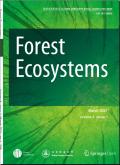Assessment of the heartwood contribution to carbon accumulation in Pinus sylvestris L. trees under different forest site conditions
IF 4.4
1区 农林科学
Q1 FORESTRY
引用次数: 0
Abstract
Background
The heartwood (HW) proportion in the trunk of mature trees is an important characteristic not only for wood quality but also for assessing the role of forests in carbon sequestration. We have for the first time studied the proportion of HW in the trunk and the distribution of carbon and extractives in sapwood (SW) and HW of 70–80 year old Pinus sylvestris L. trees under different growing conditions in the pine forests of North-West Russia.
Method
We have examined the influence of conditions and tree position in stand (dominant, intermediate and suppressed trees) in the ecological series: blueberry pine forest (Blu) – lingonberry pine forest (Lin) – lichen pine forest (Lic). We have analyzed the influence of climate conditions in the biogeographical series of Lin: the middle taiga subzone – the northern taiga subzone – the transition area of the northern taiga subzone and tundra.
Results
We found that the carbon concentration in HW was 1.6%–3.4% higher than in SW, and the difference depended on growing conditions. Carbon concentration in HW increased with a decrease in stand productivity (Blu-Lin-Lic). In medium-productive stands, the carbon concentration in SW was higher in intermediate and supressed trees compared to dominant trees. In the series from south to north, carbon concentration in HW increased by up to 2%, while in SW, it rose by 2.7%–3.8%.
Conclusions
Our results once again emphasized the need for an empirical assessment of the accurate carbon content in aboveground wood biomass, including various forest growing conditions, to better understand the role of boreal forests in carbon storage.
不同林地条件下心材对红松碳积累的贡献评估
背景成熟树木树干中的心材(HW)比例不仅是木材质量的重要特征,也是评估森林固碳作用的重要依据。我们首次研究了俄罗斯西北部松树林中不同生长条件下 70-80 年树龄的欧洲赤松(Pinus sylvestris L.)树干中的心材比例以及边材(SW)和心材中碳和萃取物的分布情况。方法我们研究了蓝莓松树林(Blu)-越橘松树林(Lin)-地衣松树林(Lic)生态系列中条件和树木在林分中位置(优势树、中间树和抑制树)的影响。我们分析了林生物地理系列中气候条件的影响:中泰加亚区-北泰加亚区-北泰加亚区和苔原的过渡区。结果我们发现,高纬度地区的碳浓度比西南部地区高 1.6%-3.4%,其差异取决于生长条件。随着林分生产力(Blu-Lin-Lic)的降低,HW 中的碳浓度也随之增加。在中等生产力的林分中,与优势树种相比,中等树种和被抑制树种的西南部碳浓度较高。结论我们的研究结果再次强调,需要对包括各种森林生长条件在内的地上木质生物量中的碳含量进行准确的实证评估,以更好地了解北方森林在碳储存中的作用。
本文章由计算机程序翻译,如有差异,请以英文原文为准。
求助全文
约1分钟内获得全文
求助全文
来源期刊

Forest Ecosystems
Environmental Science-Nature and Landscape Conservation
CiteScore
7.10
自引率
4.90%
发文量
1115
审稿时长
22 days
期刊介绍:
Forest Ecosystems is an open access, peer-reviewed journal publishing scientific communications from any discipline that can provide interesting contributions about the structure and dynamics of "natural" and "domesticated" forest ecosystems, and their services to people. The journal welcomes innovative science as well as application oriented work that will enhance understanding of woody plant communities. Very specific studies are welcome if they are part of a thematic series that provides some holistic perspective that is of general interest.
 求助内容:
求助内容: 应助结果提醒方式:
应助结果提醒方式:


